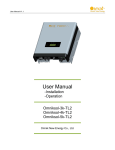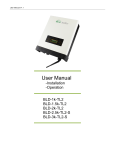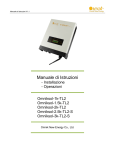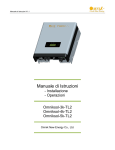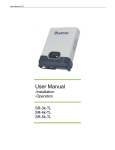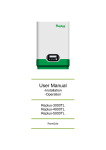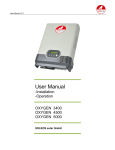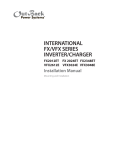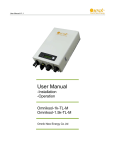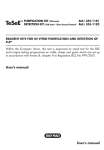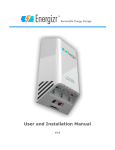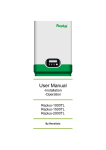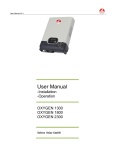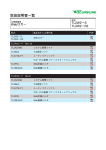Download User Manual
Transcript
User Manual V1.2 User Manual -Installation -Operation SR-3k-TL2 SR-4k-TL2 SR-5k-TL2 Catalog 1. 2. 3. 4. 5. 6. 7. Notes on this manual ......................................................................................................... 3 1.1 Scope of Validation ....................................................................................................... 3 1.2 Symbols Used ............................................................................................................... 3 1.3 Target Group ................................................................................................................ 4 Preparation ........................................................................................................................ 5 2.1 Safety Instructions......................................................................................................... 5 2.2 Explanations of Symbols on Inverter ............................................................................. 7 Product Information............................................................................................................ 8 3.1 Overview ....................................................................................................................... 8 3.2 Major Characteristics .................................................................................................... 9 3.3 Datasheet .....................................................................................................................10 Packing checklist ..............................................................................................................12 4.1 Assembly parts.............................................................................................................12 4.2 Product Appearance ....................................................................................................13 4.3 Product Identification ....................................................................................................14 4.4 Further Information .......................................................................................................14 Installation .........................................................................................................................15 5.1 Safety ...........................................................................................................................15 5.2 Mounting Instructions ...................................................................................................15 5.3 Safety Clearance..........................................................................................................16 5.4 Mounting Procedure .....................................................................................................17 5.5 Safety lock....................................................................................................................20 Electrical Connection ........................................................................................................22 6.1 Safety ...........................................................................................................................22 6.2 AC Side Connection .....................................................................................................22 6.3 DC Side Connection .....................................................................................................25 6.4 Communication and Monitoring Device ........................................................................29 Display and Operation ......................................................................................................30 7.1 LCD Panel ....................................................................................................................30 7.2 Commissioning.............................................................................................................31 7.3 Operation .....................................................................................................................31 7.4 State Information ..........................................................................................................43 8. Recycling and Disposal .....................................................................................................44 9. Troubleshooting ................................................................................................................45 10. Abbreviation ......................................................................................................................47 2 1. Notes on this manual 1.1 Scope of Validation The main purpose of this User’s Manual is to provide instructions and detailed procedures for installing, operating, maintaining, and troubleshooting the following three types of Inverters: 3k-TL2 4k-TL2 5k-TL2 Please keep this user manual all time available in case of emergency. 1.2 Symbols Used DANGER DANGER indicates a hazardous situation which, if not avoided, will result in death or serious injury. WARNING WARNING indicates a hazardous situation which, if not avoided, can result in death or serious injury or moderate injury. CAUTION CAUTION indicates a hazardous condition which, if not avoided, can result in minor or moderate injury. 3 NOTICE NOTICE indicates a situation that can result in property damage, if not avoided. 1.3 Target Group Chapter 1, 2, 3, 4, 7, 8, 9, 10 and chapter 11 are intended for anyone who is intended to use Grid Tie Solar Inverter. Before any further action, the operators must first read all safety regulations and be aware of the potential danger to operate high-voltage devices. Operators must also have a complete understanding of this device’s features and functions. WARNING Do not use this product unless it has been successfully installed by qualified personnel in accordance with the instructions in Chapter 5. “Installation” Chapter 5 and chapter 6 are only for qualified personnel who are intended to install or uninstall the Grid Tie Solar Inverter. NOTICE Hereby qualified personnel means he/she has the valid license from the local authority in: • Installing electrical equipment and PV power systems (up to 1000 V). • Applying all applicable installation codes. • Analyzing and reducing the hazards involved in performing electrical work. • Selecting and using Personal Protective Equipment (PPE). 4 2. Preparation 2.1 Safety Instructions DANGER DANGER due to electrical shock and high voltage DO NOT touch the operating component of the inverter, it might result in burning or death. TO prevent risk of electric shock during installation and maintenance, please make sure that all AC and DC terminals are plugged out. DO NOT stay close to the instruments while there is severe weather conditions including storm, lighting etc. WARNING The installation, service, recycling and disposal of the inverters must be performed by qualified personnel only in compliance with national and local standards and regulations. Please contact your dealer to get the information of authorized repair facility for any maintenance or repairmen. Any unauthorized actions including modification of product functionality of any form will affect the validation of warranty service; We may deny the obligation of warranty service accordingly. 5 NOTICE Public utility only The PV inverter designed to feed AC power directly into the public utility power grid; do not connect AC output of the device to any private AC equipment. CAUTION The PV inverter will become hot during operation; please don’t touch the heat sink or peripheral surface during or shortly after operation. Risk of damage due to improper modifications. Never modify or manipulate the inverter or other components of the system. 6 2.2 Explanations of Symbols on Inverter Symbol Description Dangerous electrical voltage This device is directly connected to public grid, thus all work to the inverter shall only be carried out by qualified personnel. DANGER to life due to high electrical voltage! There might be residual currents in inverter because of large capacitors. Wait 10 MINUTES before you remove the front lid. NOTICE, danger! This device directly connected with electricity generators and public grid. Danger of hot surface The components inside the inverter will release a log of heat during operation, DO NOT touch aluminum housing during operating. An error has occurred Please go to Part 10 “Trouble Shooting” to remedy the error. This device SHALL NOT be disposed of in residential waste Please go to Part 9 “Recycling and Disposal” for proper treatments. Without Transformer This inverter does not use transformer for the isolation function. Standards Association of Australian The inverter complies with the requirement of the AS4777. CE Mark Equipment with the CE mark fulfils the basic requirements of the Guideline Governing Low-Voltage and Electromagnetic Compatibility. No unauthorized perforations or modifications Any unauthorized perforations or modifications are strictly forbidden, if any defect or damage (device/person) is occurred, we shall not take any responsibility for it. 7 3. Product Information 3.1 Overview Industrial Layout 8 Excellent Heat Elimination 3.2 Effective Shield For DC/AC/Communication Connections Major Characteristics Inverter has following characteristics which make inverter “High Efficiency, High Reliability, High Cost Effective Ratio” Wide DC input voltage and current range, enables more PV panels connected. Wide MPP voltage range ensure high yield under various weather conditions. High MPP tracking accuracy, ensure the minimum power loses during converting. Complete set of protection methods. Also, following protection methods are integrated in inverter: Internal overvoltage DC insulation monitoring Ground fault protection Grid monitoring Ground fault current monitoring DC current monitoring Integrated DC switch (Optional) 9 3.3 Datasheet Type Input (DC) 3k-TL2 4k-TL2 5k-TL2 Max. PV Power 3400W 4500W 5000W 590V 590V 590V Max DC Voltage 360V 360V 360V 120 - 550V 120 - 550V 120 - 550V 150 - 500V 200 - 500V 200 - 500V 150V 150V 150V 120V 120V 120V Max. DC Current Max. Short Circuit Current for each MPPT Number of MPP trackers 12A/12A 16A/16A 18A/18A 16A/16A 20A/20A 20A/20A 2 Max. Input Power for each MPPT Number of DC Connection for each MPPT DC Connection Type 2000W 2 2600W 2 3000W 1/1 1/1 1/1 MC4 connector MC4 connector MC4 connector 3300VA 4400VA 5000VA* Nominal DC Voltage Operating MPPT Voltage Range MPPT Voltage Range at Nominal Power Start up DC Voltage Turn off DC Voltage Output (AC) Max. AC Apparent Power Nominal AC Power(cos phi = 1) Nominal Grid Voltage Nominal Grid Frequency Max. AC Current Grid Voltage Range* 3000W 4000W 5000W** 220V/230V/240V 220V/230V/240V 220V/230V/240V 50Hz/60Hz 50Hz/60Hz 50Hz/60Hz 14.4A 19.0A 22.0A 185-276V 185-276V 185-276V 45-55Hz/55-65Hz 0.95 capacitive…0.95 inductive <2% 45-55Hz/55-65Hz 0.95 capacitive…0.95 inductive <2% 45-55Hz/55-65Hz 0.95 capacitive…0.95 inductive <2% Feed in Starting Power 30W 30W 30W Night time Power Consumption <1W <1W <1W Standby Consumption 6W 6W 6W Plug-in connector Plug-in connector Plug-in connector Max. Efficiency (at 360Vdc) 98.2% 98.2% 98.2% Euro Efficiency (at 360Vdc) 97.3% 97.5% 97.5% MPPT Efficiency 99.9% 99.9% 99.9% Grid Frequency Range* Power Factor Total Harmonic Distortion (THD) AC Connection Type Efficiency Safety and Protection DC Insulation Monitoring DC Switch Residual Current Monitoring Unit (RCMU) Grid Monitoring with Anti-islanding Protection Class Overvoltage Category 10 Yes Optional Integrated Yes I (According to IEC 62103) PV II / Mains III (According to IEC 62109-1) Type Reference Standard Safety Standard EMC Standard Grid Standard 3k-TL2 4k-TL2 5k-TL2 EN 62109, AS/NZS 3100 EN 61000-6-1, EN 61000-6-3, EN 61000-6-2, EN 61000-6-4, EN61000-3-2, EN61000-3-3, EN61000-3-11, EN61000-3-12 VDE-AR-N-4105, VDE 0126-1-1, RD1699, CEI0-21, C10/11, G83/2, UTE C15-712-1, AS4777, CQC Physical Structure Dimensions (WxHxD) Weight Environmental Protection Rating Cooling Concept Mounting Information 352x421x162.5mm 16.5kg IP 65 (According to IEC 60529) Internal fan convection Wall bracket General Data Operating Temperature Range Relative Humidity -20°C to +60°C(derating above 45℃) 0% to 98%, no condensation Max. Altitude (above sea level) 2000m Noise Level < 40dB Isolation Type Display Data Communication Interfaces Computer Communication Standard Warranty Transformerless 3 LED, Backlight,20 x 4 Character LCD RS485(WiFi, GPRS, intergrated) USB 10 Years (15 years optional) *The AC voltage and frequency range may vary depending on specific country grid **4600VA, 4600W with VDE-AR-N-4105 11 4. Packing checklist 4.1 Assembly parts After you receive the inverter, please check if there is any damage on the carton, and then check the inside completeness for any visible external damage on the inverter or any accessories. Contact your dealer if anything is damaged or missing. 12 A B C E F G D Object Quantity Description A 1 Inverter B 2 pairs DC connector C 1 AC connector D 1 Wall mounting bracket E 4 Screw (ST6×50) F 4 Expansion tube G 1 Installation and operating instructions 4.2 Product Appearance B Front A C D Object Description A Removable front shield B LED light (3 pcs) C Function keys for displays and choice of language(4 pcs) D Monitoring LCD with backlighting Bottom A B C D 13 Object 4.3 Description A DC switch (optional) B Plug connectors for DC input C Terminal for grid connection (AC output) D Communication interface(RS485/GPRS/WiFi/USB) Product Identification You can identify the inverter by the side name plate. Information such as type of the inverter, as well as inverter specifications are specified on the side name plate. The name plate is on the middle part of the right side of the inverter housing. And the following figure is the side name plate example as on 3k-TL2. 4.4 14 Further Information If you have any further questions concerning the type of accessories or installation, please check our website www.saronic.de or contact our service hotline. 5. Installation 5.1 Safety DANGER DANGER to life due to potential fire or electricity shock. DO NOT installs the inverter near any inflammable or explosive items. This inverter will be directly connected with HIGH VOLTAGE power generation device; the installation must be performed by qualified personnel only in compliance with national and local standards and regulations. NOTICE NOTICE due to the inappropriate or the harmonized installation environment may jeopardize t he life span of the inverter. Installation directly expose under intensive sunshine is not recommended. The installation site MUST have good ventilation condition. 5.2 Mounting Instructions Inverter is designed for indoors and outdoors installation 15 5.3 Please mount the inverter in the direction as illustrated above Install the inverter in the vertical direction is recommended, with a max.15 degrees backwards. For the convenience of checking the LCD display and possible maintenance activities, please install the inverter at eye level. Make sure the wall you selected is strong enough to handle the screws and bear the weight of the inverter Ensure the device is properly fixed to the wall It is not recommended that the inverter is exposed to the strong sunshine, because the excess heating might lead to power reduction The ambient temperature of installation site should be between -20 °C and +60 °C ( between -4 °F and 140 °F ) Make sure the ventilation of the installation spot, not sufficient ventilation may reduce the performance of the electronic components inside the inverter and shorten the life of the inverter Safety Clearance Observe the following minimum clearances to walls, other devices or objects to guarantee sufficient heat dissipation and enough space for pulling the electronic solar switch handle. 16 Direction Minimum clearance Above 30 cm 40 cm Sides 10 cm Mounting Procedure 1. Mark 4 positions of the drill holes on the wall according to the wall mounting bracket in the carton box. 304 (Depth 50mm) 300 5.4 Below 2. According to the marks, drill 4 holes in the wall. Then place four expansion tubes in the holes using a rubber hammer. Next make 4 screws through the mounting holes in 17 the bracket, and then tighten the screws into the expansion tubes. So far, the wall mounting bracket is fixed already. 18 3. Check the 4 holes in the backside of the inverter. Then lift the inverter carefully, align the 4 holes in the inverter and the 4 hooks on the bracket, and finally attach the inverter to the hooks slightly. 19 5.5 Safety lock After the inverter is hanging up on the bracket, lock up the device and the bracket together at the Lower Left Corner of the inverter (as the picture showed below). Padlock Recommended padlock dimension: A B C A.Shackle Diameter 5~7 mm B.Vertical Clearance 8~15 mm C.Horizontal Clearance 12~20 mm Stainless, solid hanger and secured lock cylinder NOTICE For further maintenance and possible repair, please keep the key of the padlock in a safe place. 20 21 6. Electrical Connection 6.1 Safety DANGER DANGER to life due to potential fire or electricity shock. With the inverter powered, comply with all prevailing national regulations on accidents prevention. This inverter will be directly connected with HIGH VOLTAGE power generation device; the installation must be performed by qualified personnel only in compliance with national and local standards and regulations. NOTICE Electrical connections shall be carried out in accordance with the applicable regulations, such as conductor sections, fuses, PE connection. 6.2 AC Side Connection DANGER DANGER to life due to potential fire or electricity shock. NEVER connect or disconnect the connectors under load. 1. Integrated RCD and RCM The inverter is equipped with integrated RCD (Residual Current Protective Device) and RCM (Residual Current Operated Monitor). The current sensor will detect the volume of the leakage current and compare it with the pre-set value, if the leakage current exceeds the permitted range, the RCD will disconnect the inverter from the AC load. 2. Assembly Instructions 22 NOTICE Use 14-12AWG (2-4mm 2 ) copper wire for all AC wiring connections to inverter. Use only solid wire or stranded wire. 1) Remove length y of N,L conductor 35mm(1.38’’)/PE conductor 40mm(1.57’’) sheath of AC cable terminal, length x about 14mm(0.55’’) of the inner wrapper, then dress the conductor terminals with ferrules or tin soldering. 2) Check that all parts of AC connector are present. Then slide hex nut onto the cable and insert the cable end through clamp ring. 3) Insert the stripped N, L and PE conductor terminal to the appointed holes, use a cross screwdriver to tighten it with tightening torque 1Nm. 23 4) Insert the connector to clamp ring with two click sound and then tighten the hex nut with tightening torque 4Nm. 5) Finally connect the straight plug to the AC terminal on inverter. Pay attention to the polarity of the terminals to avoid wrong connecting. 24 6.3 DC Side Connection DANGER DANGER to life due to potential fire or electricity shock. NEVER connect or disconnect the connectors under load. NOTICE DC Switch (Optional) may be integrated or external to Inverter, and it can be used to connect or disconnect the DC source from Inverter. For 3k-TL2, 4k-TL2 and 5k-TL2, there are two MPP Trackers, and the DC characteristics of them are illustrated as the following table. Inverter Type MPP Tracker 3k-TL2 4k-TL2 Max. DC Power Max. DC Voltage 3400W 2 5k-TL2 4600W Max. DC Current 12*2A 590V 5200W 16*2A 18*2A MC4 Assembly instructions If, during self assembly, parts and tools other than those stated by MC are used or if the preparation and assembly instructions described here are disregarded then neither safety nor compliance with the technical data can be guaranteed. For protection against electric shock, PV-connectors must be isolated from the power supply while being assembled or disassembled. The end product must provide protection from electric shock. The use of PVC cables is not recommended. Unplugging under load: PV plug connections must not be unplugged while under load. They can be placed in a no load state by switching off the DC/AC converter or breaking the DC circuit interrupter. Plugging and unplugging while under voltage is permitted. 25 It is unadvisable to use non-tinned cables of type H07RN-F, since with oxidized copper wires the contact resistances of the crimp connection may exceed the permitted limits. Disconnected connectors should be protected from dirt and water with sealing caps. Plugged parts are watertight IP67. They cannot be used permanently under water. Do not lay the MC-PV connectors on the roof surface. See the MC catalogue 2 solar lines for technical data and assembled parts. PV-Female cable coupler PV-Male cable coupler PV-KBT4 PV-KST4 Touch protection, mated/unmated Ambient temperature range Upper limiting temperature Optional PV-SSH4 IP67/IP2X Rated current 17A(1,5mm2/16AWG) 22A(2,5mm2/14AWG) 30A(4mm2,6mm2/10AWG) -40°to 90°C (IEC/CEI) -40°to 75°C(UL) -40°...70°C (UL:14AWG) Rated voltage 1000V (IEC/CEI) 600V (UL) 105°C (IEC/CEI) Safety class II Note: The DC connector is MC4 type; you can order the specified tools at MC website: http://www.multi-contact.com. Tools required (ill. 1) Stripping pliers PV-AZM... incl. built-in blade as well as hexagonal screwdriver A/F 2,5mm. Cable cross section: 1,5 / 2,5 / 4 / 6 mm² Type: PV-AZM-1.5/6 Order No. 32.6029-156 (ill. 2) Crimping pliers PV-CZM... incl. locator and built-in crimping insert. Crimping range: 2,5 / 4 / 6 mm²(12 / 10 AWG) Type: PV-CZM-19100 Order No. 32.6020-19100 26 (ill. 3) Open-end spanner PV-MS, 1 Set = 2 pieces Order No.: 32.6024 (ill. 4) PV-WZ-AD/GWD socket wrench insert to tighten Order No. 32.6006 (ill. 5) PV-SSE-AD4 socket wrench insert to secure Order No. 32.6026 (ill. 6) Test plug PV-PST Order No. 32.6028 (ill. 7) Open-end spanner A/F 15 mm (ill. 8) Torque screwdriver A/F 12 mm Cable preparation (ill. 9) Use 14-10AWG (2.5-6mm2) conductor as DC cable. Dimension A 3-6mm, b 2.5-6mm2 (ill. 10) Strip the cable end L with 6 mm to 7.5 mm of insulation. 27 (ill. 11) Open the clamp (K) and hold. Place the contact in the appropriate cross section range. Turn the crimp lugs upwards. Release the clamp (K). The contact is fixed. (ill. 12) Press the pliers gently together until the crimp lugs are properly located within the crimping die. (ill. 13) Insert the stripped cable end until the insulation comes up against the crimp insert. Completely close the crimping pliers. (ill. 14) Visually check the crimp. (ill. 15) Insert the crimped-on contact into the insulator of the male or female coupler until it clicks into place. Pull gently on the lead to check that the metal part is correctly engaged. (ill. 16) Insert the appropriate end of the test pin into the male or female coupler as far as it will go. If the contact is correctly located, the white mark on the test pin must still be visible. 28 (ill. 17) Screw up the cable gland hand-tight with the tools PV-MS or tighten the cable gland with the tools PV-WZ-AD/GWD and PV-SSE-AD4. In both cases: The tightening torque must be appropriate for the solar cables used. Typical values are between 2,5 Nm and 3 Nm. (ill. 18) Plug the parts of the cable coupler together until they click in place. Check that they have engaged properly by pulling on the cable coupler. 6.4 Communication and Monitoring Device There are 2 RJ45 plugs in the bottom side of the inverter as the following figure: These 2 RJ45 plugs are used for multipoint communications, that is, up to 50 inverters can be connected one by one through these 2 plugs and the cables, the upper computer can communicate with these inverters via a single signal cable at the same time, and maximum length of the cable is 1000m. Through these plugs, the user can get the data from these inverters, and can also configure parameters of them. 29 7. Display and Operation 7.1 LCD Panel Object Description A LED light(Yellow) – COM B LED light(Green) – RUN C LED light(Red) – FAULT D UP key E DOWN key F ESC key G ENTER key The LCD panel is integrated in the front lid of the inverter, so it is easy for user to check and set the data. In addition, the user can press the function key to illuminate the LCD screen. NOTICE Inverter is not an aligned measuring instrument for current, voltage or power consumption. A slight deviation of a few percent points is intrinsic to the system; the results from the inverter cannot be used for grid balance calculations. An aligned meter will be required to make calculations for the utility company. 30 7.2 Commissioning NOTICE The power supply of display module is AC grid, so the screen will not be available until AC is connected. A minimum available voltage of 150Vdc and a DC power of >10Wdc is required before the inverter starts feeding power to the grid. AC side: Turn on the AC circuit break and the display module will works. DC side: Turn on the DC switch. When the inverter is started for the first time, a menu is displayed to choose language and the country where the inverter installed, English, Dutch and Deutsch are available for display. NOTICE You need to confirm that you choose the right country safety to ensure that compliance with local standards. 7.3 Operation 7.3.1 System operation interface System operation interface 1: 31 In this interface, the displayed “Waiting 0” part will switch along with the system operation status. The system will have the following status: 1. Waiting status: Display as Waiting XXX, XXX refers to the countdown time, will display 1~3 numbers. 2. Flash status: Display as Flash 3. Fault status: Display as Fault XX, XX refers to error code, will display 1~2 numbers. Power and EToday in this interface will change along with the change of number after system operation. System operation interface 2: Power and ETotal in this interface will change along with the change of number after system operation. System operation interface 3: 32 This interface displays the input voltage and current of the 2 input PV panel. System operation interface 4: This interface displays the voltage and frequency of grid and the current which inverter outputs to the grid. System operation interface 5: This interface displays the WiFi information of the inverter, including WiFi SN and IP address. 7.3.2 Interface introduction Safety Interface: When choose “Safety” by pressing compound key (ESC+ENTER) in system operation interface 1 for 3 seconds. 33 Safety “Italy” in the screen flickers. After confirm to enter, password dialog box appears. The default password is “654321”. After entering the password, system will get to the safety selection interface. Safety selection interface: The selected safety information flickers. The selectable safety information as following: 34 Italy VDE-4105 VDE-0126 Spain GREMAIN Portugal Belgium Italy _ S EnglG83 EnglG59 Austral China GerBDEW Dan mark GreIsla Czech Slovak Holland Sweden Bulgaria France Brazil EngG592 Holl16A SAfrica These safety information will be arranged in 4 lines, i.e. there will be 4 safety information displayed in the same interface. Info Interface: You can choose “Info” by UP and DOWN key in system operation interface 1 While “Info” flickers. Confirm to enter Info mode. There will be 7 interfaces in the Info mode. 1. PV panel information: 2. AC grid information: 35 36 3. Inverter’s Model information: 4. Inverter’s SN Information: 5. Inverter’s master CPU information: 6. Inverter’s slave CPU information: 7. Inverter’s display module version information: Error record display interface: You can choose “Error” by UP and DOWN key in system operation interface 1 While “Error” flickers, confirm to enter the Error record mode. Interface number of the Error record mode is unfixed; it ranges from 0 to 9 interfaces. No error record interface: 37 Recent error record interface: Earliest error record interface: Set mode: You can choose “Set” by UP and DOWN key in system operation interface 1 While “Set” flickers, confirm to enter the Set mode. The Set mode is operated with 2 levels of menu. There are five items in the sub-menu, Time, Data, Password, Language and WiFi. The items are shown as following picture. 38 Choose the item which needs adjustment by UP and DOWN key in the sub-menu. The flickering one is the selected item. Setting Language: In the Set mode, choose Language by Up and Down key (as shown in the picture) While “Language” flickers, confirm to enter the language option list. Choose the target language, the corresponding language flickers. English, Dutch and Deutsch are available for displaying. Click ENTER to save data and back to prior menu. Changing Password: In the Set mode, choose “Password” by UP and DOWN key as shown in the picture. 39 While “Password” flickers, confirm to enter the password modified interface. Input 6 figure passwords, check correctness and enter the modified mode Save password after the end of input Back to two-level menu mode after saving the password Setting Time: In the Set mode, choose “Time” by UP and DOWN key as shown in the picture. 40 While “Time” flickers, confirm to enter the inverter time setting mode. There are hour, minute and second displayed in the time setting mode. Use ENTER key to choose the one you want modify and UP/DOWN key to change the value. Setting Date: In the Set mode, choose “Date” by UP and DOWN key as shown in the picture. While “Date” field flickers, confirm to enter the inverter Date Setting mode 41 There are day, month and year displayed in the date setting mode, Set date by Up/Down key. Confirm to enter the next setting data, the sequence is day/month/year. After setting year, back to the two-level menu mode. 42 7.4 State Information State Wait Display State information Waiting Initialization & waiting Reconnects Reconnect Checking’s Checking Normal Normal Fault Normal state Current Fault GFCI failure oversized leakage current Master Grid Freq Fault Grid frequency failure Master Grid Freq Fault Grid voltage failure PV Voltage Fault Input voltage too high Over Temp Fault Temperature abnormal Isolation Fault Isolation failure Relay1 Fault Output relay failure Relay2 Fault Current DC Offset Output DC injection too high Eeprom Fault EEPROM problem SCI Lose Serial communication interface failure Hole Sense Device Fault Output AC sensor abnormal Flash GFCI Failure GFCI testing device abnormal F/W Updating Update About the further information for each fault, please reference to chapter “9.Troubleshooting”. 43 8. Recycling and Disposal To comply with European Directive 2002/96/EC on waste Electrical and Electronic Equipment and its implementation as national law, electrical equipment that has reached the end of its life must be collected separately and returned to an approved recycling facility. Any device that you no longer required must be returned to your dealer or you must find an approved collection and recycling facility in your area. Ignoring this EU Directive may have severe affects on the environment and your health. 44 9. Troubleshooting Resumable Fault LCD display Possible actions Isolation Fault 1. Check the impedance between PV (+) & PV (-) and the inverter is earthed. The impedance must be greater than 2M. 2. Check whether the AC-side has contacts with earth. Current Fault 1. The ground current is too high. 2. After cut off the AC side connection, unplug the inputs from the PV generator and check the peripheral AC system. 3. After the cause is cleared, re-plug the PV panel and AC connection, and check PV-Inverter status. Master Grid Freq Fault Master Grid Volt Fault 1. Wait for a moment, if the grid returns to normal, PV-Inverter automatically restarts. 2. Make sure grid voltage and frequency meet the specifications. No Utility Over Temp Fault PV Voltage Fault 1. 2. 3. 4. 1. The internal temperature is higher than specified normal value. 2. Find a way to reduce the ambient temperature. 3. Or move the inverter to a cooler environment. 1. Check the open PV voltage; see if it is greater than or too close to 590VDC (for 3k-TL2 or 4k-TL2 or 5k-TL2). 2. If PV voltage is less than 590VDC, and the problem still occurs, please call local service. ENS Grid Voltage Fault ENS Grid Freq Fault Permanent Fault Grid is not connected. Check grid connection cables. Check grid usability. If grid is ok, and the problem persists, maybe the fuse in the inverter is open, please call service. Disconnect PV (+) or PV (-) from the input, restart the inverter. Relay1 Fault Relay2 Fault Current DC Offset Eeprom Fault SCI Lose Hole Sense Device Fault GFCI Device Fault 1. 2. 3. 4. Disconnect ALL PV (+) or PV (-). Wait for a few seconds. After the LCD switches off, reconnect and check again. If the problems remain please call local service. 45 Error code list: 46 ERROR CODE Description 0 1 2 3 4 5 6 7 8 9 10 11 12 13 14 15 16 17 18 19 20 21 22 23 24 25 26 27 28 29 30 31 GFCI Device Fault Hole Sense Device Fault Reference Device Fault DCI ENS Fault GFCI ENS Fault Less Bus Low Voltage Fault Over Bus High Voltage Fault Master Device Fault Master Delta Grid Z Fault No Utility Current Fault Bus Voltage Fault B12 Over Temp Fault Auto Test fail PV Voltage Fault Fan Fault Master Grid Volt Fault Isolation Fault Current DC Offset ENS Grid VFZ Fault ENS Grid Z Fault ENS Grid Freq Fault ENS Grid Voltage Fault Relay2 Fault Relay1 Fault Slave Grid Z Fault Master Grid Z Fault Slave Grid Freq Fault Master Grid Freq Fault Eeprom Fault SCI Lose 10. Abbreviation LCD Liquid Crystal Display LED Light Emitting Diode MPPT Maximum Power Point Tracking PV Photovoltaic Vdc Voltage at the DC side Vac Voltage at the AC side Vmpp Voltage at the Maximum Power Point Impp Amperage at Maximum Power Point AC Alternating Current ( Form of electricity supplied by Utility Company ) DC Direct Current ( Form of electricity generated by PV modules ) VDE 0126-1-1 German standard for establishing suitability for Grid Connection of the Inverter VDE-AR-N 4105 German new standard for establishing suitability for Grid Connection of the Inverter. Including active and reactive power adjusting function DC Switch Switch in the DC Circuit. Disconnects DC source from Inverter. May be integrated or external to Inverter 47

















































